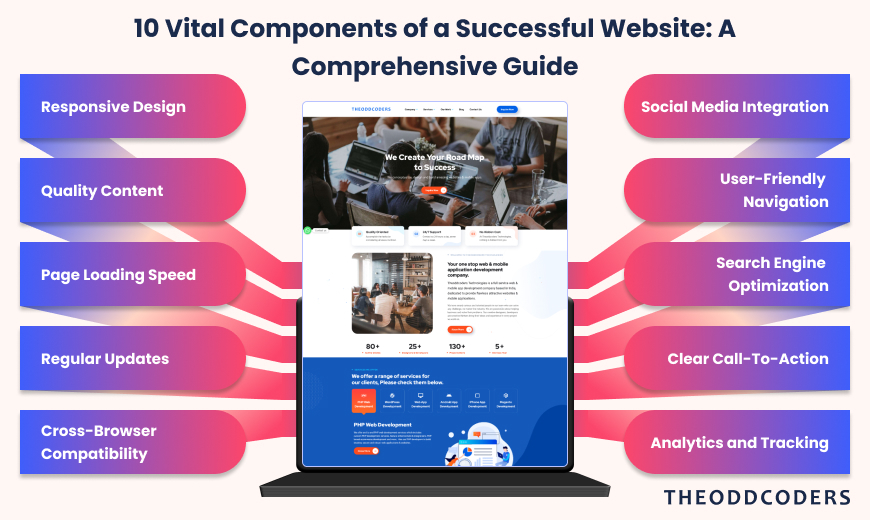
A user-friendly and engaging website will make an instant positive impression on the clients, improving the overall user experience and increasing the clients’ engagement. However, you need help understanding what elements will make a great website with great functionality. This blog will give you the critical 10 elements that will create an innovative, well-designed, successful website design for your business.
The Importance of a Good Website
In today’s digital age, the significance of a well-crafted website extends far beyond mere online presence it is the virtual storefront, the digital ambassador of a brand or business. A good website is the first impression, a critical touchpoint influencing how visitors perceive and interact with a venture. A website’s development gives it seamless navigation and an intuitive design that guides users effortlessly, leaving them with a positive experience.
Crucially, a website is a powerful marketing tool. It’s a dynamic platform to showcase products, services, or ideas, reaching a global audience 24/7. Search Engine Optimization (SEO) is pivotal in identifying a website’s visibility. A well-optimized site attracts organic traffic and establishes credibility and trust.
Moreover, a good website development service will help to increase user engagement. Clear Calls-to-Action (CTAs) prompt visitors to take desired actions, whether purchasing, subscribing to updates, or contacting the business. Analytics tools offer invaluable insights, enabling data-driven decisions for continual improvement.
In simple words, a good website is not just pixels and code; it’s a strategic asset that can increase a brand’s performance, expand its reach, and cultivate lasting connections in the ever-evolving digital realm. It’s the virtual handshake, the online storefront, and the heartbeat of a successful digital presence.
Factors to Consider for a Good Website
A website design is the first impression and defines how visitors interact with the content. Due to this, many large companies hire web developers to develop their sites to attract more clients.
#1 Responsive Design
A successful website design starts with a responsive design adapted to the various devices and screen sizes. It gives a user experience and increases the SEO rankings with the help of mobile-friendly sites. A responsive framework assures that visitors will get appropriate content in a visually appealing and accessible manner. It also increases user engagement and satisfaction. Thus, responsive website design is the most essential part of the website, which gives user-centric functionality and search engine visibility for optimal website performance.
#2 Quality Content
It is considered the core part of the website that will get a visitor back with its engaging, informative, and relevant nature—increasing your brand identity by making high-quality content to reach your targeted audience efficiently. Implementing images, videos, and interactive elements will enrich the user experience by giving them deep content. Hence, the existence of any website is dependent on the information that will attract and sustain the audience with your content for a long time.
#3 Page Loading Speed
Page loading speed is the most crucial factor for a positive user experience. Moreover, faster loading times will also help you enhance user satisfaction and reduce bounce rates. It will also help you to optimize your website by compressing images and minimizing unnecessary code. It would help if you also considered content delivery networks (CDNs) for distributing the content efficiently.
However, users are increasingly accessing websites on smartphones. A swift and responsive website improves user engagement and positively impacts search engine rankings by increasing overall online success. Thus, regularly monitoring and optimizing loading speeds will provide your audience with a seamless browsing experience..
#4 Regular Updates
If you want a successful website design, then you need regular updates. Regularly Implementing new and updated content, features, practices, and trends is most important. These updates will convey to search engines that your site is active and that it will positively impact rankings. It also sustains user interest and positions your website as a dynamic presence within various industries. Thus, in this ever-evolving technology, the commitment to regular updates is the proactive method that ensures that your website will help you stay active, update, and follow the latest trends to remain in this competitive market.
#5 Cross-Browser Compatibility
In the web browser, web developers focus on the importance of cross-platform compatibility. Ensure that your website works seamlessly on well-known browsers like Chrome, Safari, Edge, and so on. Despite the browser preference, it must boost a positive user experience for visitors.
A website’s development must be accessible and user-friendly to a wide range of audiences by providing reliability and scalability. Thus, ensuring cross-browser compatibility is necessary to maintain a consistent user experience with the increasing number of internet browsers.
#6 Social Media Integration
Social media implementation is the most crucial part of website development. Incorporating social media features increases your online presence and gives users the effort to share the content, expands visibility, and drives increased website traffic. You can use social networks by creating a close relationship between your website and social media platforms.
It will help you create an active online ecosystem where audience reach, contacts, and participation are boosted by one another. The move towards increased influence creates a strong relationship in this digital environment by adapting social media integration.
#7 User-Friendly Navigation
A successful website design and development depends on its user-friendly navigation system. Developing an intuitive and easy-to-use navigation system will help foster the user experience. This involves placing calls to action in intelligent places, providing clear menu selections, and offering accessible routes to relevant data.
Easy navigation for users will help them quickly find what they’re looking for, which reduces bounce rates and encourages prolonged engagement time. Having a high priority on ease of navigation makes users happy and helps websites that value user experience rank higher in search engine results. In the end, a well-designed navigation system is crucial for optimizing your website’s potential and maintaining users’ interest in your website for a long time.
#8 Search Engine Optimization (SEO)
For website development, it is essential to know the basic SEO concepts for increasing your presence in the digital market. Search engine optimization (SEO) services significantly impact your website’s visibility on search engines, from accurate keyword optimization to well-written meta tags.
To ensure relevance in search results, keep your content updated and modified by the search algorithms that are constantly updating. You can improve your website ranking and organic traffic by building a solid online presence and remaining updated with SEO best practices. Hence, in this competitive digital market, it is essential to understand search engine algorithms, which are dynamic; continuing to work toward SEO optimization prepares your website for long-term visibility and success.
#9 Clear Call-To-Action
Calls-to-Action (CTAs) on a visually appealing website are clear and simple, which helps users do specific tasks. Whether filling out a contact form, purchasing anything online, or subscribing to a newsletter, well-designed CTAs help them along the way.
These queries should be evident and placed thoughtfully to draw visitors’ attention to your site. You can create a user experience that not only informs but also inspires, which will match CTAs for your audience. This will eventually lead to the desired interactions and conversions. In simple terms, the efficiency and strength of a website’s calls to action in guiding users toward significant involvement are generally used to evaluate its performance and the success of the website.
#10 Analytics and Tracking
Use analytics tools to track user activity and gain valuable information about the performance of your website. For an in-depth understanding of your website, you can use analytics to help you make well-informed decisions, improve the content, and customize your website to match user expectations.
However, this data-driven methodology will help you improve the user experience for the strategic purposes of ongoing improvement. You can also use analytics to measure click-through rates, page views, and user demographics to enhance your online presence and track user preferences and industry trends.
Conclusion
One cannot overstate the importance of a well-designed website. It serves as a virtual storefront and a powerful marketing tool, which will make a first impression on visitors.
However, the essential elements for a good website include responsive design, quality content, mobile optimization, regular updates, cross-browser compatibility, social media integration, user-friendly navigation, SEO, clear CTAs, and analytics, which will create a successful online presence.
Connect with the best website development company in India, like Theoddcoders Technologies, who have an expertise team that will help you and your businesses strive and succeed in this digital market.
Read More :- How Much Does a Small Business Website Cost? A Complete Guide



